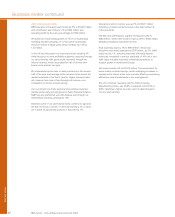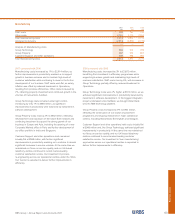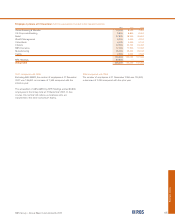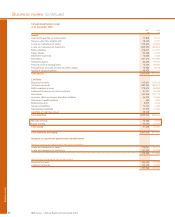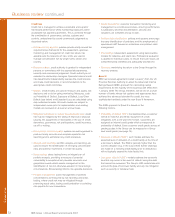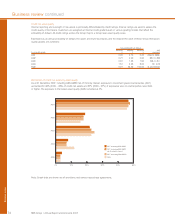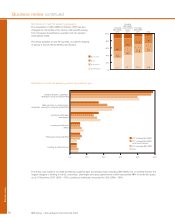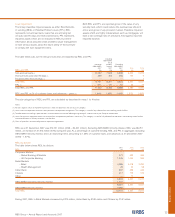RBS 2007 Annual Report Download - page 74
Download and view the complete annual report
Please find page 74 of the 2007 RBS annual report below. You can navigate through the pages in the report by either clicking on the pages listed below, or by using the keyword search tool below to find specific information within the annual report.
RBS Group • Annual Report and Accounts 2007
72
Business review continued
Business review
Credit risk
Credit risk is managed to achieve sustainable and superior
risk-reward performance whilst maintaining exposures within
acceptable risk appetite parameters. This is achieved through
the combination of governance, policies, systems and
controls, underpinned by sound commercial judgement as
described below.
•Policies and risk appetite: policies provide clarity around the
required Group framework for the assessment, approval,
monitoring and management of credit risk where risk
appetite sets the tolerance of loss. Limits are used to
manage concentration risk by single name, sector and
country.
•Decision makers: credit authority is granted to independent
persons or committees with the appropriate experience,
seniority and commercial judgement. Credit authority is not
extended to relationship managers. Specialist internal credit
risk departments independently oversee the credit process
and make credit decisions or recommendations to the
appropriate credit committee.
•Models: credit models are used to measure and assess risk
decisions and to aid on-going monitoring. Measures, such
as Probability of Default, Exposure at Default, Loss Given
Default (see below) and Expected Loss are calculated using
duly authorised models. All credit models are subject to
independent review prior to implementation and existing
models are reviewed on at least an annual basis.
•Mitigation techniques to reduce the potential for loss: credit
risk may be mitigated by the taking of financial or physical
security, the assignment of receivables or the use of credit
derivatives, guarantees, risk participations, credit insurance,
set off or netting.
•Risk systems and data quality: systems are well organised to
produce timely, accurate and complete inputs for risk
reporting and to administer key credit processes.
•Analysis and reporting: portfolio analysis and reporting are
used to ensure the identification of emerging concentration
risks and adverse movements in credit risk quality.
•Stress testing: stress testing forms an integral part of
portfolio analysis, providing a measure of potential
vulnerability to exceptional but plausible economic and
geopolitical events which assists management in the
identification of risk not otherwise apparent in more benign
circumstances. Stress testing informs risk appetite decisions.
•Portfolio management: active management of portfolio
concentrations as measured by risk reporting and stress
testing, where credit risk may be mitigated through
promoting asset sales, buying credit protection or curtailing
risk appetite for new transactions.
•Credit stewardship: customer transaction monitoring and
management is a continuous process, ensuring performance
is satisfactory and that documentation, security and
valuations are complete and up to date.
•Problem debt identification: policies and systems encourage
the early identification of problems and the employment of
specialised staff focused on collections and problem debt
management.
•Provisioning: independent assessment using best practice
models for collective and latent loss. Professional evaluation
is applied to individual cases, to ensure that such losses are
comprehensively identified and adequately provided for.
•Recovery: maximising the return to the Group through the
recovery process.
Basel II
RBS has received agreement (called ‘a waiver’) from the UK
Financial Services Authority to adopt the Advanced Internal
Ratings Based (AIRB) approach for calculating capital
requirements for the majority of the business with effect from
1 January 2008. The Group, therefore, will be one of a small
number of banks whose risk systems and approaches have
achieved the advanced standard for credit, the most
sophisticated available under the new Basel II framework.
The AIRB approach to Basel II is based on the
following metrics.
•Probability of default (“PD”): the likelihood that a customer
will fail to make full and timely repayment of credit
obligations over a one year time horizon. Customers are
assigned an internal credit grade which corresponds to
probability of default. Every customer credit grade across all
grading scales in the Group can be mapped to a Group
level credit grade (see page 74).
•Exposure at default (“EAD”): such models estimate the
expected level of utilisation of a credit facility at the time of
a borrower’s default. The EAD is typically higher than the
current utilisation (e.g. in the case where further drawings
are made on a revolving credit facility prior to default) but
will not typically exceed the total facility limit.
•Loss given default (“LGD”): models estimate the economic
loss that may occur in the event of default, being the debt
that cannot be recovered. The Group’s LGD models take into
account the type of borrower, facility and any risk mitigation
such as security or collateral held.


